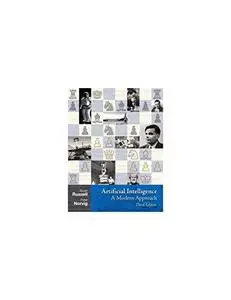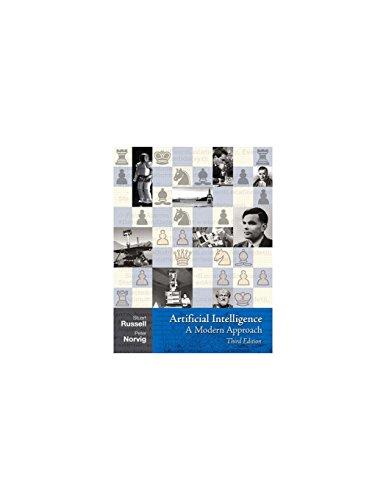Artificial intelligence: a modern approach By Stuart J Russell; Peter Norvig; Ernest Davis; et al
2010 | 1152 Pages | ISBN: 0136042597 | PDF | 14 MB
2010 | 1152 Pages | ISBN: 0136042597 | PDF | 14 MB
From the Publisher: The long-anticipated revision of this number 1 selling book offers the most comprehensive, state of the art introduction to the theory and practice of artificial intelligence for modern applications. Intelligent Agents. Solving Problems by Searching. Informed Search Methods. Game Playing. Agents that Reason Logically. First-order Logic. Building a Knowledge Base. Inference in First-Order Logic. Logical Reasoning Systems. Practical Planning. Planning and Acting. Uncertainty. Probabilistic Reasoning Systems. Making Simple Decisions. Making Complex Decisions. Learning from Observations. Learning with Neural Networks. Reinforcement Learning. Knowledge in Learning. Agents that Communicate. Practical Communication in English. Perception. Robotics. For computer professionals, linguists, and cognitive scientists interested in artificial intelligence. 1: Artificial Intelligence -- 1: Introduction -- 1-1: What is AI? -- 1-2: Foundations of artificial intelligence -- 1-3: History of artificial intelligence -- 1-4: State of the art -- 1-5: Summary, bibliographical and historical notes, exercises -- 2: Intelligent agents -- 2-1: Agents and environments -- 2-2: Good behavior: the concepts of rationality -- 2-3: Nature of environments -- 2-4: Structure of agents -- 2-5: Summary, bibliographical and historical notes, exercises -- 2: Problem-Solving -- 3: Solving problems by searching -- 3-1: Problem-solving agents -- 3-2: Example problems -- 3-3: Searching for solutions -- 3-4: Uninformed search strategies -- 3-5: Informed (heuristic) search strategies -- 3-6: Heuristic functions -- 3-7: Summary, bibliographical and historical notes, exercises -- 4: Beyond classical search -- 4-1: Local search algorithms and optimization problems -- 4-2: Local search in continuous spaces -- 4-3: Searching with nondeterministic actions -- 4-4: Searching with partial observations -- 4-5: Online search agents and unknown environments -- 4-6: Summary, bibliographical and historical notes, exercises -- 5: Adversarial search -- 5-1: Games -- 5-2: Optimal decisions in games -- 5-3: Alpha-beta pruning -- 5-4: Imperfect real-time decisions -- 5-5: Stochastic games -- 5-6: Partially observable games -- 5-7: State-of-the-art game programs -- 5-8: Alternative approaches -- 5-9: Summary, bibliographical and historical notes, exercises -- 6: Constraint satisfaction problems -- 6-1: Defining constraint satisfaction problems -- 6-2: Constraint propagation: inference in CSPs -- 6-3: Backtracking search for CSPs -- 6-4: Local search for CSPs -- 6-5: Structure of problems -- 6-6: Summary, bibliographical and historical notes, exercises -- 3: Knowledge. Reasoning And Planning -- 7: Logical agents -- 7-1: Knowledge-based agents -- 7-2: Wumpus world -- 7-3: Logic -- 7-4: Propositional logic: a very simple logic -- 7-5: Propositional theorem proving -- 7-6: Effective propositional model checking -- 7-7: Agents based on propositional logic -- 7-8: Summary, bibliographical and historical notes, exercises -- 8: First-order logic -- 8-1: Representation revisited -- 8-2: Syntax and semantics of first-order logic -- 8-3: Using first-order logic -- 8-4: Knowledge engineering in first-order logic -- 8-5: Summary, bibliographical and historical notes, exercises -- 9: Inference in first-order logic -- 9-1: Propositional vs first-order inference -- 9-2: Unification and lifting -- 9-3: Forward chaining -- 9-4: Backward chaining -- 9-5: Resolution -- 9-6: Summary , bibliographical and historical notes, exercises -- 10: Classical planning -- 10-1: Definition of classical planning -- 10-2: Algorithms for planning as state-space search -- 10-3: Planning graphs -- 10-4: Other classical planning approaches -- 10-5: Analysis of planning approaches -- 10-6: Summary, bibliographical and historical notes, exercises -- 11: Planning and acting in the real world -- 11-1: Time, schedules, and resources -- 11-2: Hierarchical planning -- 11-3: Planning and acting in nondeterministic domains -- 11-4: Multiagent planning -- 11-5: Summary, bibliographical and historical notes, exercises -- 12: Knowledge representation -- 12-1: Ontological engineering -- 12-2: Categories and objects -- 12-3: Events -- 12-4: Mental events and mental objects -- 12-5: Reasoning systems for categories -- 12-6: Reasoning with default information -- 12-7: Internet shopping world -- 12-8: Summary, bibliographical and historical notes, exercises -- 4: Uncertain Knowledge And Reasoning -- 13: Quantifying uncertainty -- 13-1: Acting under uncertainty -- 13-2: Basic probability notation -- 13-3: Inference using full joint distributions -- 13-4: Independence -- 13-5: Bayes' rule and its use -- 13-6: Wumpus world revisited -- 13-7: Summary, bibliographical and historical notes, exercises -- 14: Probabilistic reasoning -- 14-1: Representing knowledge in an uncertain domain -- 14-2: Semantics of Bayesian networks -- 14-3: Efficient representation of conditional distributions -- 14-4: Exact inference in Bayesian networks -- 14-5: Approximate inference in Bayesian networks -- 14-6: Relational and first-order probability models -- 14-7: Other approaches to uncertain reasoning -- 14-8: Summary, bibliographical and historical notes, exercises -- 15: Probabilistic reasoning over time -- 15-1: Time and uncertainty -- 15-2: Inference in temporal models -- 15-3: Hidden Markov models -- 15-4: Kalman filters -- 15-5: Dynamic Bayesian Networks -- 15-6: Keeping track of many objects -- 15-7: Summary, bibliographical and historical notes, exercises -- 16: Making simple decisions -- 16-1: Combining beliefs and desires under uncertainty -- 16-2: Basis of utility theory -- 16-3: Utility functions -- 16-4: Multiattribute utility functions -- 16-5: Decision networks -- 16-6: Value of information -- 16-7: Decision-theoretic expert systems -- 16-8: Summary, bibliographical and historical notes, exercises -- 17: Making complex decisions -- 17-1: Sequential decision problems -- 17-2: Value iteration -- 17-3: Policy iteration -- 17-4: Partially observable MDPs -- 17-5: Decisions with multiple agents: game theory -- 17-6: Mechanism design -- 17-7: Summary, bibliographical and historical notes, exercises -- Learning -- 18: Learning from examples -- 18-1: Forms of learning -- 18-2: Supervised learning -- 18-3: Learning decision trees -- 18-4: Evaluating and choosing the best hypothesis -- 18-5: Theory of learning -- 18-6: Regression and classification with linear models -- 18-7: Artificial neural networks -- 18-8: Nonparametric models -- 18-9: Support vector machines -- 18-10: Ensemble learning -- 18-11: Practical machine learning -- 18-12: Summary, bibliographical and historical notes, exercises -- 19: Knowledge in learning -- 19-1: Logical formulation of learning -- 19-2: Knowledge in learning -- 19-3: Explanation-based learning -- 19-4: Learning using relevance information -- 19-5: Inductive logic programming -- 19-6: Summary, bibliographical and historical notes, exercises -- 20: Learning probabilistic models -- 20-1: Statistical learning -- 20-2: Learning with complete data -- 20-3: Learning with hidden variables: the EM algorithm -- 20-4: Summary, bibliographical and historical notes, exercises -- 21: Reinforcement learning -- 21-1: Introduction -- 21-2: Passive reinforcement learning -- 21-3: Active reinforcement learning -- 21-4: Generalization in reinforcement learning -- 21-5: Policy search -- 21-6: Applications of reinforcement learning -- 21-7: Summary, bibliographical and historical notes, exercises -- 6: Communicating, Perceiving, And Acting -- 22: Natural language processing -- 22-1: Language models -- 22-2: Text classification -- 22-3: Information retrieval -- 22-4: Information extraction -- 22-5: Summary, bibliographical and historical notes, exercises -- 23: Natural language for communication -- 23-1: Phrase structure grammars -- 23-2: Syntactic analysis (parsing) -- 23-3: Augmented grammars and semantic interpretation -- 23-4: Machine translation -- 23-5: Speech recognition -- 23-6: Summary, bibliographical and historical notes, exercises -- 24: Perception -- 24-1: Image formation -- 24-2: Early image-processing operations -- 24-3: Object recognition by appearance -- 24-4: Reconstructing the 3D world -- 24-5: Object recognition form structural information -- 24-6: Using vision -- 24-7: Summary, bibliographical and historical notes, exercises -- 25: Robotics -- 25-1: Introduction -- 25-2: Robot hardware -- 25-3: Robotic perception -- 25-4: Planning to move -- 25-5: Planning uncertain movements -- 25-6: Moving -- 25-7: Robotic software architectures -- 25-8: Application domains -- 25-9: Summary, bibliographical and historical notes, exercises -- 7: Conclusions -- 26: Philosophical foundations -- 26-1: Weak AI: can machines act intelligently? -- 26-2: Strong AI: can machines really think? -- 26-3: Ethics and risks of developing artificial intelligence -- 26-4: Summary, bibliographical and historical notes, exercises -- 27: AI: Present and future -- 27-1: Agent components -- 27-2: Agent architectures -- 27-3: Are we going in the right direction? -- 27-4: What if AI does succeed? -- A: Mathematical background -- A-1: Complexity analysis and O() notation -- A-2: Vectors, matrices, and linear algebra -- A-3: Probability distributions -- B: Notes on languages and algorithms --B-1: Defining languages with Backus-Naur form (BNF) -- B-2: Describing algorithms with pseudocode -- B-3: Online help -- Bibliography -- Index



